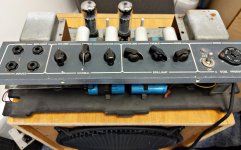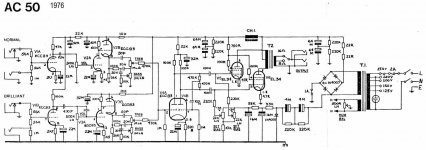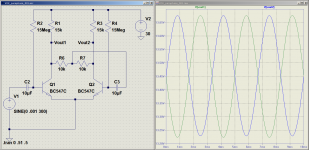Thus summer's project. Bringing a 1976 VOX AC50 head back to life after decades in a damp garage.
The pots were crackly and slack(!) I had to crimp the four metal tags on each pot to make the back cover tight enough to ensure the wiper made contact with the track. Weird. Then I applied switch cleaner and in general the pots are OK now.
Then after some hum and some light guitar playing - a crackle and no output at all.
So I get in with the meter. The HT is high and doesn't droop when the heaters warm up. The output bias point seems to show neither EL34 are taking any current. That would explain some of the high HT then.
I dig deeper. Both control grids are at -175 volts! Well that would stop the output pentodes taking current. What I find is part of the bias circuit has a broken wire. Also weird.
Anyway, I fix that, check all the dc voltages, re-set the output bias slightly on the cold side and now we have the beginnings of a working AC50. My goodness this thing is loud. And it weighs a ton. The output transformer is immense. The power transformer is even bigger.
We do plan to change the big electrolytics and maybe some of the smaller ones. But otherwise I want to leave it with its patina. All the aluminium is powdery and the steel has a dusting of brown. The front diamond cloth as a small rip.
Perfect 🙂
Pete

The pots were crackly and slack(!) I had to crimp the four metal tags on each pot to make the back cover tight enough to ensure the wiper made contact with the track. Weird. Then I applied switch cleaner and in general the pots are OK now.
Then after some hum and some light guitar playing - a crackle and no output at all.
So I get in with the meter. The HT is high and doesn't droop when the heaters warm up. The output bias point seems to show neither EL34 are taking any current. That would explain some of the high HT then.
I dig deeper. Both control grids are at -175 volts! Well that would stop the output pentodes taking current. What I find is part of the bias circuit has a broken wire. Also weird.
Anyway, I fix that, check all the dc voltages, re-set the output bias slightly on the cold side and now we have the beginnings of a working AC50. My goodness this thing is loud. And it weighs a ton. The output transformer is immense. The power transformer is even bigger.
We do plan to change the big electrolytics and maybe some of the smaller ones. But otherwise I want to leave it with its patina. All the aluminium is powdery and the steel has a dusting of brown. The front diamond cloth as a small rip.
Perfect 🙂
Pete

Last edited:
In my experience, refurbishing VOX/WEM/Marshall and Fender amplifiers, if the capacitors are not open circuit or leaking, leave them alone. That will help to retain the value of the amplifier.
In the unlikely event they are faulty, replace with the same type.
In the unlikely event they are faulty, replace with the same type.
Really?
I'm quite happy to leave them in there and save hassle and money, but just slightly concerned they might just give way some day..
I am impressed by the industrial style of the amp build. It is a tag strip build, not PCB, with lots of wires neatly bent at 90 degrees. However 470v B+ is, shall we say, intimidating
Pete
PS - Love your web site.. I will bookmark it.
🙂
P
I'm quite happy to leave them in there and save hassle and money, but just slightly concerned they might just give way some day..
I am impressed by the industrial style of the amp build. It is a tag strip build, not PCB, with lots of wires neatly bent at 90 degrees. However 470v B+ is, shall we say, intimidating
Pete
PS - Love your web site.. I will bookmark it.
🙂
P
You will find they are fine left alone after running the amp for an hour or two, if they are going to fail, that is the time they will.
In the 60s and 70s, we used to make components to last and electrolytic capacitors had a slightly different manufacturing process than today's cheap and let them die in a year or two, technology. At Daly Condensers, in Weymouth, we used belt and braces to build our components, unlike today. Maybe that is why the Chinese took over for cheapness and Daly went out of business in the 80s .....
In the 60s and 70s, we used to make components to last and electrolytic capacitors had a slightly different manufacturing process than today's cheap and let them die in a year or two, technology. At Daly Condensers, in Weymouth, we used belt and braces to build our components, unlike today. Maybe that is why the Chinese took over for cheapness and Daly went out of business in the 80s .....
In that case I will leave them in situ and give the beast a long power on soak test when we have finished with the switch cleaner. If they can survive that then they should be OK I guess.
BTW. Oh, that Advance signal generator... I used one of those when I worked at Harwell in the late sixties.
.. In fact I just checked. The AC50 has Teletron 32+32uF condensers* but I can't see a date code.
*That's a word I haven't used for a while 🙂
BTW. Oh, that Advance signal generator... I used one of those when I worked at Harwell in the late sixties.
.. In fact I just checked. The AC50 has Teletron 32+32uF condensers* but I can't see a date code.
*That's a word I haven't used for a while 🙂
Production of the AC50 started around Jan 7th 1963 according to the first schematics and production finished around 1975. So, the capacitor could be anywhere in between! I can't remember the codes we used to use for the year but A was January B was Feb etc. Not sure if we just used the last two digits from the year or used a batch number. To check if it is a really early model, the bridge rectifiers were BY100 type, the newer models had 1N4007s. Nice amplifiers!
What will the world do when the likes of us older generation pack up repairing and refurbishing older reliable gear. My sons didn't want to join me in my workshop saying they will "buy a new one when it stops working", a real shame!
What will the world do when the likes of us older generation pack up repairing and refurbishing older reliable gear. My sons didn't want to join me in my workshop saying they will "buy a new one when it stops working", a real shame!
I'm pretty certain it has 1N4007s in the bridge. I spotted a 76 date code on one of the pots so I figure it is after that. The bias circuit seems to be slightly different to the 1965 schematic I printed off. So I imagine it is a later one. The rear panel label is laminated and says Vox Sound Limited.
I recently gave my 14 year old guitar mad grandson one of my home made 4 watt Princeton style single ended 6AQ5 amps. He is well impressed and prefers it to his Marshall 100 and H&K valve amps, particularly for late night practice.
Maybe the new wave of boutique amp designers will carry the torch forward repairing and keeping the old gear working.
Maybe valves will be banned when the world runs out of electricity 🙂
I recently gave my 14 year old guitar mad grandson one of my home made 4 watt Princeton style single ended 6AQ5 amps. He is well impressed and prefers it to his Marshall 100 and H&K valve amps, particularly for late night practice.
Maybe the new wave of boutique amp designers will carry the torch forward repairing and keeping the old gear working.
Maybe valves will be banned when the world runs out of electricity 🙂
Thanks for that.. The tail resistor on the fixed bias shows up as 10k, not 2K as on the older circuit. That ties up with measurements I made.
It was in fact that 10K that had become disconnected so the bias voltage was totally wrong. However I'm glad it failed to "output valves turned" off rather than zero bias and maximum anode current...
Also - reminds me I should check that hum balancing pot next time it is opened up.
It was in fact that 10K that had become disconnected so the bias voltage was totally wrong. However I'm glad it failed to "output valves turned" off rather than zero bias and maximum anode current...
Also - reminds me I should check that hum balancing pot next time it is opened up.
It's really nice to hear about a young person who cares about anything other than his @#^%!* smartphone. And even nicer to hear about a young person interested in something that requires lots of persistence and effort before there's any payoff....my 14 year old guitar mad grandson...
Let's hope your grandson has many years of fulfilling music-making in front of him! 🙂
Back to the AC50, is that a paraphase phase splitter? It looked like an LTP at first glance, then I did a double-take when I noticed the fully bypassed, 820 ohm tail resistor (which clearly isn't actually a tail resistor at all!)
I still don't understand how the feedback from the junction of the two 470k resistors to V4B grid works to create the two balanced phases. Won't the signal at that junction be zero if the two out-of-phase signals are equal in amplitude?
Perhaps the idea is that V4B has sufficiently high voltage gain to require only a very small signal at it's control grid, which means the two anode signals from V4 are nearly equal and opposite, as they sum to nearly zero?
-Gnobuddy
Yes, that LTP design had me scratching my head slightly. If you want to make it a differential amplifier then you could use both grids as inputs, and I have seen that as a way of returning the feedback loop or combining two preamps. But as we know Vox don't do feedback 🙂
So with a single input you strictly need to decouple the other unused input. My guess is the balanced resistors and coupling capacitor creates a kind of virtual earth which does the job. I also suspect it linearises the stage and balances the two outputs as well.
The tail resistor is fully bypassed for max gain, at the expense of linearity. But that sums up the early Vox valve output stage design right there...
I've been asked how it sounds fully cranked. I don't know and dont intend to find out - not without some stout resistors 🙂
Pete
So with a single input you strictly need to decouple the other unused input. My guess is the balanced resistors and coupling capacitor creates a kind of virtual earth which does the job. I also suspect it linearises the stage and balances the two outputs as well.
The tail resistor is fully bypassed for max gain, at the expense of linearity. But that sums up the early Vox valve output stage design right there...
I've been asked how it sounds fully cranked. I don't know and dont intend to find out - not without some stout resistors 🙂
Pete
I came to the same conclusion. If the second triode had infinite voltage gain, it would do whatever is necessary to create zero signal (virtual earth) at the junction of those two 470k resistors - and that would mean the signal at the second anode was equal and opposite to the first, i.e. a balanced, phase-inverted copy. Very clever!My guess is the balanced resistors and coupling capacitor creates a kind of virtual earth which does the job. I also suspect it linearises the stage and balances the two outputs as well.
In practice with a non-infinite voltage gain of 50 - 60, I guess there will be a tiny imbalance in the two signals. Not enough to matter.
I simulated the circuit in LTSpice, using transistors for expediency and scaling down some resistor values accordingly. It works very well, as you can see!
Oh, man. I can see it now, 100 W or 200 W resistors mounted on a giant, fan-cooled heatsink. And earplugs. And industrial strength Ear Defenders ( Ear Defenders - Compact Foldable Comfortable & Adjustable Hearing Protection - Ear Protectors Shooting Ear Muffs - Great for Men Women Adults Kids Children - Noise Reduction for Construction & Yard Work Loud Noises Mowing the Lawn Concert Fireworks Drums Autism Meditation - 2 Years Warranty - Black, Earmuffs - Amazon Canada ) on top of the earplugs. 😱I've been asked how it sounds fully cranked. I don't know and don't intend to find out - not without some stout resistors 🙂
Pete
-Gnobuddy
Attachments
My good friend and former guitar player loved his AC50.All original,it needed nothing more than a good cleaning and some fresh EL34s.
He played an old Les Paul with P90 pickups,an equally old Marshall 4x12 bass cab,and an Echoplex.Man,what a tone.......
Damn,that boy was loud!
He played an old Les Paul with P90 pickups,an equally old Marshall 4x12 bass cab,and an Echoplex.Man,what a tone.......
Damn,that boy was loud!
I spent some time with a scope on this AC50, something is wrong in the HT department. There's a distinct lack of smoothing, some 100Hz hum, no oscillation that I can see (with our 500MHz scope).
So, we plan to swap the big electrolytics as a first step. It would be nice to keep it original but it needs to work properly 🙂
Pete
So, we plan to swap the big electrolytics as a first step. It would be nice to keep it original but it needs to work properly 🙂
Pete
A tail piece to the VOX refurb. We replaced the two dual electrolytics in the pre-amp department and that fixed the hum. The pots and jacks have been cleaned and right now it is sounding just great. I think we saved it from the scrap heap 🙂
- Status
- Not open for further replies.
- Home
- Live Sound
- Instruments and Amps
- Bang! Careful now. AC50 refurb.

